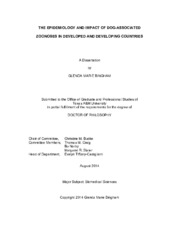| dc.description.abstract | Dogs are an important part of human societies throughout the world. Although people derive many economic and health benefits from their relationships with dogs, these relationships are not without risk. Interaction with dogs can lead to an increased risk for zoonotic diseases, if the appropriate precautions are not taken. While dogs contribute to the transmission of a variety of zoonoses, only a
few of these diseases, such as rabies and cystic echinococcosis, are recognized as having widespread economic and public health implications.
In order to assess the knowledge and perceptions of dog-associated zoonoses in Brazos County, Texas, random digit dialing was used to select households for participation in a cross-sectional telephone survey. Of the 1691 households, which were contacted, 922 (55%) completed the interview. Dog owners accounted for 56% of the study participants. Eighty-six percent of the
respondents indicated they would report being bitten by a dog that they did not own. Factors that were shown to be significantly associated with bite reporting included, age, sex, urbanicity, and rabies knowledge. Many of the respondents lacked knowledge about dog-associated zoonoses, which could seriously affect their health.
Cystic echinococcosis (CE) is known to be endemic in Rio Negro Province, Argentina. However, current epidemiological data were not available for this region. A community-based CE screening study, which incorporated diagnostic imaging and a questionnaire, was conducted to evaluate the prevalence of human CE and identify locally relevant risk factors in the study population. The overall CE prevalence among the community volunteers was 7.1%, with 1.6% of children, and 10% of adults diagnosed as CE-positive. Age, level of education, dog ownership, and contact with sheep were found to be significantly associated with CE status.
In regions of the world where CE is highly endemic, it has been shown to be a substantial financial burden for those who are affected. When the costs associated with human CE, obtained from hospital chart reviews and patient interviews, were combined with livestock-associated costs obtained from government reports and scientific publications, the estimated total annual cost of CE in Rio Negro Province was $5,100,373 (95% CI: $2,852,345–$8,004,122). | en |


